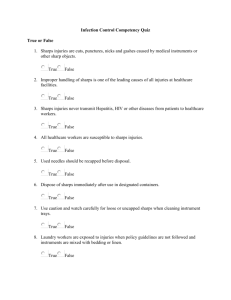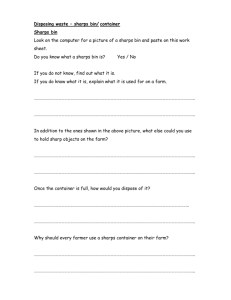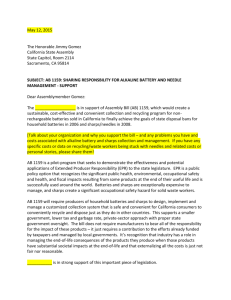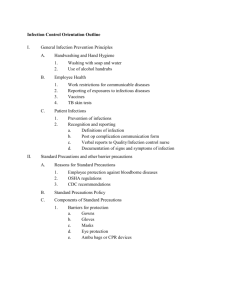Risk Assessment Sheet : RA01 - Inspire Healthcare Services
advertisement
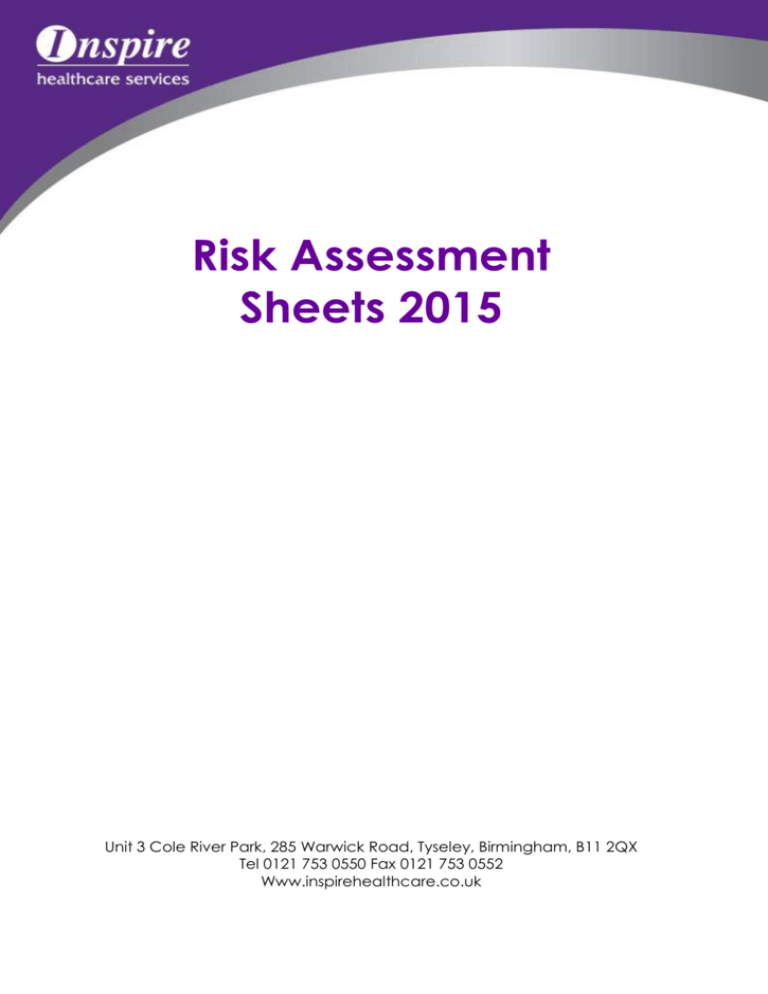
Risk Assessment Sheets 2015 Unit 3 Cole River Park, 285 Warwick Road, Tyseley, Birmingham, B11 2QX Tel 0121 753 0550 Fax 0121 753 0552 Www.inspirehealthcare.co.uk Risk Assessment Sheet : RA01 Risk Title : Accidents/Illness/Incidents Inspire Healthcare Services have a duty to inform the authorities when employees suffer from certain accidents or illnesses. In order to help IHS perform this duty we require the following : Always ; Report all accidents, incidents, near misses and injuries or work related conditions to your manager, at the first available opportunity. Report all and any accidents /injuries to the contact on site, when carrying out work for IHS on customers premises. Ensure any injury is examined and treated if necessary by an appointed first aider. Ensure all information pertaining to the incident is provided for the accident book. Inform, immediately your manager should you suffer any after effects resulting from any accident or injury. Remember! To inform your manager of any injury or condition sustained outside of normal working hours as this may affect your ability to perform your duty safely. This would include being prescribed medication by your GP that in turn could affect your ability to drive safely. Emergency Procedures Sharps injuries In cases of injuries sustained by needles or other sharp objects; - remove the object and encourage to bleed wash injury thoroughly with cold running water attend the local hospital for further treatment and tests for and blood borne infections if you can, without causing further injury, take the object in a secure sharps container, with you to the hospital January 2015 RA01 Chemical splashes In cases of injuries sustained by splashing of chemicals or other substances - wash with clean running water, the affected area should the eye be affected wash with clean water or if available eye wash for at least 15 minutes remove immediately any contaminated clothing if in any pain, or redness does not subside attend hospital for further treatment January 2015 RA01 Risk Assessment Sheet : RA02 Risk Title : Toilet Seat Sanitizer Personnel at Risk: Operative Hazards : Excessive skin contact with cleaning fluids To ensure safety, the following precautions must be observed : Always ; If possible avoid direct skin contact with toilet seat sanitizer fluid Wash your hands regularly to remove any residue Securely store all cartridges on your vehicle and keep separate from any waste items Ensure all lids are secure to prevent spillage or leakage Ensure any spillages are cleaned up immediately Ensure any problems with toilet seat sanitizer are to reported to the site contact and your manager January 2015 RA02 Risk Assessment Sheet : RA03 Risk Title : Sharps Units Personnel at Risk: Operative Hazards : Infection from needlestick injuries To ensure safety the following precautions must be followed: Always ; Wear protective gloves when handling sharps containers Ensure all cuts and abrasions are covered with waterproof plasters Make sure hands are washed on a regular basis Ensure lids are secure and all tops sealed Ensure all units are correctly labelled with customer account details Carry the sharps unit by the handle only Store sharps units in segregated area of vehicle ensuring unit is secured properly Report any problems relating to the sharps unit immediately Seek treatment immediately if you receive an injury from a sharps object Keep up to date with your vaccinations Never ; Unless specifically trained on relevant waste procedures, do not carry out sharps collections Mix sharps units with other waste or non waste items Touch split sharps units, always use the spillage kit provided to collect damaged units Collect sharps units in non-UN containers, in overflowing containers or any makeshift unit January 2015 RA03 Risk Assessment Sheet : RA04 Risk Title : Servicing Sanitary/Clinical and Nappy Disposal Units Personnel at Risk: Operative Hazards : Injuries & illness from contact with contents of waste units To ensure safety the following precautions should be followed: Always ; Wear gloves for the safe handling of sanitary/clinical and nappy units Ensure all cuts and abrasions are covered with waterproof plasters Make sure your hands are washed on a regular basis Ensure all units are secure to prevent spillage Ensure all liner bags have been correctly sealed for transportation Carry liner bags by the neck and hold away from the body Make sure that all sanitary and nappy waste is segregated from any other waste types Inform immediately the site contact and your manager, if any any waste incorrectly stored in units, such as needles and glass Notify the site contact and your manager if units have been overfilled or are excessively heavy Follow correct procedure for handling waste liner bags Never ; service split waste or overfilled units by hand, use the protective equipment provided January 2015 RA04 Risk Assessment Sheet : RA05 Risk Title : Air Freshener/Battery and mains operated Personnel at Risk: Operative Hazards : Skin/eye contact with chemicals, dust or grit Contact with electrical current To ensure safety the following precautions must be followed : Always ; Wear gloves for handling gels, sachets or liquids Make sure hands are washed on a regular basis Make sure you hold Aerosol away from face when in test mode Use a step ladder for servicing equipment out of reach Position ladders to give maximum ease for servicing, reducing the need for leaning or reaching Ensure any electrical supply has been turned off before commencing service on an electrically operated air freshener Wear goggles when servicing above eye level, ie: Gels, sachets and liquids Report any problems to the site contact and your manager immediately Never ; Store aerosols in the front of your vehicle, they must always be kept in the back out of sunlight Try to repair any equipment unless fully trained to do so Interfere with electric supply of the electrical air freshener Carry batteries in your pockets Stand on cupboards, shelves and sinks or any other fittings January 2015 RA05 Risk Assessment Sheet : RA06 Risk Title : Soaps/Engineering Hand Cleaner/Barrier Cream Personnel at Risk: Operative Hazards : Excessive contact with hand cleaners and slipping over on spills To ensure safety the following precautions must be observed : Always ; Wash your hands regularly to remove hand cleaner residues Store soaps, engineering hand creams and barrier creams securely away from any waste items Ensure lids on any containers in use are securely fastened Clean any spillages of hand cleaner immediately Ensure any problems with the hand cleaner dispensers are reported to the site contact and your manager as soon as possible Never ; Attempt to repair any dispenser unless fully trained January 2015 RA06 Risk Assessment Sheet : RA07 Risk Title : Service – Vending Machines Personnel at Risk: Operative & Site Personnel Hazard : Insecure vending machines/ Loose covers To ensure safety the following precautions must be followed : Always ; Ensure that the machine is safely secured to the wall Check that the correct type and number of fixings has been used Report any damaged, Faulty or poorly maintained/installed machines immediately to the site contact and your manager Ensure the door is not obstructing your access when restocking, and when finished make sure you have securely locked the machine Keep stock separate from any waste Never ; Attempt to repair any machines unless fully trained to do so January 2015 RA07 Risk Assessment Sheet : RA08 Risk Title : Hand Dryer servicing Personnel at Risk: Operative Hazards : Electric shock To ensure safety the following precautions must be followed : Always ; Check for signs of damage and tampering Report all damaged and faulty driers immediately to the site contact and your manager Never ; Attempt to repair any machines unless full trained to do so January 2015 RA08 Risk Assessment Sheet : RA09 Risk Title : Dustmats – Servicing Personnel at Risk: Operative & Site Personnel Hazards : Injuries from lifting/carrying Injuries from fragments of metal and glass etc. Contact with infectious spillages on mats To ensure safety the following precautions must be followed : Always ; Wear gloves for the safe handling of dirty mats Keep cuts and scrapes covered with a plaster Wash hands regularly Check that mats have been laid correctly to avoid a trip hazard Re-apply any anti-slip tape or secondary rubber backing after each service For reasons of contamination (ie. Human/animal products) ensure that mats are placed in bags /containers for transportation if contaminated Report to the site contact and your service manager if mats have caused tripping so that remedial action can be taken immediately Load mats on vehicle taking into account servicing sequence Use trolleys for removal of mats where provided Follow correct procedure for lifting and carrying mats Store mats separately to waste items on vehicle Never ; Attempt to remove a mat by tugging them from the bottom of the pile Attempt to carry excessive quantities of mats Leave mats in Door/stairways when servicing January 2015 RA09 Risk Assessment Sheet : RA10 Risk Title : Toilet/urinal sanitizers Personnel at Risk: Operative Hazard : Skin/eye contact with sanitizing fluid To ensure safety the following precautions must be followed : Always ; Wash splashes thoroughly with clean water the affected area Change clothes that have been contaminated Wear eye/face protection when replacing cartridges or for refilling units that are at or above eye level Use the stepladders for units out of reach Position ladders safely so you can easily reach the unit Place cartridge in unit by pushing at edges, taking care not to squeeze in the middle Take care not to overfill the Reservoirs on old style of units Ensure all cartridges are stored safely on vehicle and lids have been secured to prevent leakage, and keep away from any waste items Report to the site contact and your manager if any difficulties are encountered Never ; Refill a sanitizer if you do not have a clear view – ask for the unit to be re-sited Service an inaccessible unit sited behind panels – unless trained to do so using the correct handling equipment Service a sanitizer unless you have been fully trained Stand on sinks, shelves or other fittings January 2015 RA10 Risk Assessment Sheet : RA11 Risk Title : Waste/liner bag collections Personnel at Risk: Operative Hazard : Handling injuries Infection from needlestick injuries and germs in waste To ensure safety the following precautions must be followed : Always ; Wear gloves when handling waste Ensure all cuts and scrapes are covered with a waterproof plaster Wash your hands regularly Ensure all bags have been sealed correctly Hold the bag by the neck only and keep away from the body Be alert, in case needles or glass have been mistakenly placed in bags Report immediately to the site contact and your manager any bags that are overfilled or contain the wrong type of waste Report any sharps injury immediately for treatment Ensure that the waste bags are stored securely in the designated area on your vehicle Follow the correct procedure for lifting and handling of heavy objects Never ; Store waste bags with other waste types Store with non waste items Collect any spilt waste by hand use spillage kit provided Collect any waste that has been incorrectly packed January 2015 RA11 Risk Assessment Sheet : RA12 Risk Title : Installation/repair/uplift of non electrical equipment Personnel at Risk: Operative Hazard : Eye injuries when drilling Electrical cabling, water pipes in walls Handling injuries To ensure safety the following precautions must be followed : Always ; Wear protective eye shields provided When installing at height use the stepladder Use only the cordless drill supplied, never a mains operated drill Use only approved fittings, checking you have the correct items and quantities To complete your work Make sure you have spare drill bits and that they are the correct type Check the walls for any hidden wiring or pipework with a cable detector before you begin Ensure the you follow all instructions and product information as issued to you Use trolley where possible to move equipment Report to the site contact and your manger before you start installation – should you find any difficulties report these immediately to your manager Never ; Install, repair or uplift any equipment unless you fully trained and qualified Install an air freshener unit at low level to ensure the air freshener is not installed at face level Install air freshener or flammable products near to incandescent light bulbs and hot surfaces Use equipment you suspect may be faulty Stand on sinks, cupboards, shelves or other fittings January 2015 RA12 Risk Assessment Sheet : RA13 Risk Title : Stepladders Personnel at Risk: Operative Hazard : Falling off due to over reaching/ over balancing The stepladder slipping away Feet slipping from rung Missed footing To ensure safety the following precautions must be followed : Always ; Inspect stepladder regularly and before use for any signs of damage, any defects are to be reported immediately Ensure stepladder has level and firm footing Ensure stepladders are positioned safely to avoid reaching, re-position when necessary to prevent any accidents Place stepladders forward facing in relation to the job in hand, otherwise they may become unstable Keep ladders clear of equipment Make sure footwear is in good condition, check soles also check ladder for oil, grease, mud, and water as these may cause accidents Keep stepladders stored securely on van at all times to prevent damage Never ; Place a stepladder where it may cause an accident either by passing vehicles or people Use a stepladder that is too short always ask for a 4/5 rung step ladder to be supplied Stand on top of a stepladder Stand a stepladder on an uneven surface, boxes or planks January 2015 RA13 Risk Assessment Sheet : RA14 Risk Title : Waste segregation Personnel at Risk: Operative Hazard : Leaks/spills/damage from incorrectly stored waste Injury/illness from contact with incorrectly stored waste products Contamination of non waste To ensure safety the following precautions must be followed : Always ; Store waste and non waste separately on vehicle Store waste sacks in appointed storage area on vehicle, away from other products Store sharps in appointed area on vehicle away from waste and other products Keep the vehicle clean by washing inside and out on a regular basis Report any problems immediately to your manager where waste segregation is concerned Report any damage, spills or leakage to your manager where waste containers are concerned Never ; Store waste and non waste items together Under any circumstances store any waste products in the front of your vehicle Under any circumstances store sharps units or waste sacks anywhere but in the segregated area on the vehicle January 2015 RA14 Risk Assessment Sheet : RA15 Risk Title : Company vehicles Personnel at Risk: Operative Hazard : Involvement in an RTA Contact with diesel , engine oil or lubricants To ensure safety the following precautions must be followed : Always ; Follow the highway code Report suspected vehicle faults and damage to your manager promptly Wear seat belt at all times Ensure good visibility by cleaning regularly your windscreens, mirrors and lights Make sure your vehicle is safe by checking regularly the tyres, lights, oil and water levels Where necessary wear your high visibility vest when kerbside loading and unloading, also when site rules dictate Make sure all loads are secured and evenly spread Clean any oil or diesel spills immediately Lock your vehicle, making sure never to leave keys in the vehicle and ensure any valuables are out sight Never ; Use hand held mobile phones, eat or drink whilst driving Carry any unauthorised passengers Drive under the influence of drink, or drugs, or if on any medication that could affect your concentration or reflexes – check with your doctor January 2015 RA15 Risk Assessment Sheet : RA16 Risk Title : Manual Handling Personnel at Risk: All Staff Hazards: Injuries & illness from poor manual handling which cover the supporting or moving of loads by bodily force To ensure safety the following procedures should be followed: Always: Check; . . . . . The Task The Load The Area The Direction Condition/position Do I know what to do? How heavy is it? Can I handle it? Is there room to move/lift? Which way will I be going with the load? Am I in the best position/condition to handle the load? Ensure that you follow the general safe lifting rules. . . . . . . . . . Assess each load before attempting to lift it fully Stand close to the unit with feet spread slightly apart Bend/unlock the knees Keep back straight, not curved Ensure firm grip so the unit is held securely Slowly straighten legs, then resume upright position – do not jerk Hold the unit close to the body To change direction move your feet – do not twist the back when handling Overhead lifting of heavy containers should be avoided – lift moderate weights to head height only Never attempt to lift or move a load without following safe handling procedures January 2015 RA16 Risk Assessment Sheets Index RA01 : Accidents/Illness/Incidents RA02 : Toilet Seat Sanitizer RA03 : Sharps Units RA04 : Servicing Sanitary/Clinical and Nappy Units RA05 : Air Freshener/Battery and Mains Operated RA06 : Soaps/Engineering Hand Cleaner/Barrier Cream RA07 : Service – Vending Machines RA08 : Hand Dryer Servicing RA09 : Dustmats Servicing RA10 : Toilet/urinal Sanitizer RA11 : Waste/Liner Bag Collections RA12 : Installation/Repair/Uplift of Non Electrical Equipment RA13 : Stepladders RA14 : Waste Segregation RA15 : Company Vehicles RA16 : Manual Handling Inspire Healthcare Services January 2015


